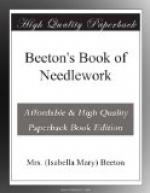[Illustration: 566.—Jewel Case, with Pincushion.]
* * * * *
567.—Guipure Pattern for Jewel Case.
Materials: Netting 25 holes square; Messrs. Walter
Evans and Co.’s
Mecklenburg thread No. 14.
This cover is worked in point d’esprit, point de toile, point de reprise, and point de feston. Thick dots are introduced occasionally.
[Illustration: 567.—Guipure Pattern for Jewel Case (No. 566).]
* * * * *
568.—Parasol Cover in Guipure d’Art. (Seepage 580.)
Materials: Messrs. Walter Evans and Co.’s Mecklenburg thread No. 20, and cotton No. 80.
For working this cover, one part of which is shown in our illustration two-thirds of its full size, work first a straight strip of netting for the foundation, which must count as many holes in width as are required for the width of the covering. The size of the holes depends on the size of the knitting-needle or mesh which you use. The pattern is worked with cotton No. 80, over a steel knitting-needle which measures two-fifths of an inch round. Begin the strip in one corner. Cast on 2 stitches, and work in rows backwards and forwards, increasing 1 stitch at the end of every row, till you have 1 stitch more than the stripe is to have holes in width, on our pattern 68 stitches; then work 1 row on the same number of stitches, and then increase alternately 1 stitch at the end of 1 row, and decrease 1 at the end of the next, till the strip is 250 stitches long. The strip is finished off in a straight line at the bottom by working a certain number of rows in which the last stitch remains untouched. At the beginning of the row do not work 1 stitch ever the mesh, but only 1 knot in the stitch of the preceding row, so that the cotton is drawn on tight. When the strip is completed, trace from No. 568 the outlines for the pattern of each of the eight parts of the parasol with double thread, in such a manner that two parts lie next to each other, but reversed, that is, the point of one part must lie next to the wide part of the next part. Then work in each part the pattern seen in illustration, and afterwards each part round with button-hole stitch, working over the double outline. Cut out the different parts, and sew them together on the wrong side with close overcast stitch.
* * * * *
[Illustration: 569.—Scent Sachet in Guipure d’Art.]
569.—Scent Sachet in Guipure d’Art.
Materials: Messrs. Walter Evans and Co.’s Mecklenburg thread No. 18; green satin; poudre d’iris; green satin ribbon; green silk cord.
The size of the netting depends on that of the sachet. The netting must be fastened in a frame, and darned with fine thread; the flowers are worked in darning stitch, and the ground in point d’esprit. The cushion is made of green satin, perfumed with poudre d’iris. When the netting has been fastened on, it is edged all round with a green satin ruche, and green silk cord, forming loops at every corner.




